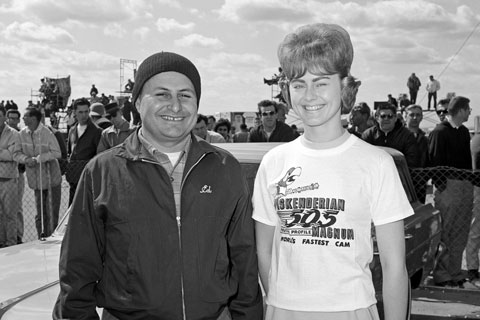SEMA News—October 2014
SEMA Heritage
Before It Was an Outlaw
By Drew Hardin
Photo Courtesy of the Petersen Archive
 Were you to park a ’14 Chevy Malibu next to a ’56 Bel Air and open the hoods of each, the contrast would be remarkable. The Malibu’s short, wide engine bay is so full of plastic covers, tubes, hoses, wires, bottles and other equipment that the car’s four-cylinder engine is barely visible—if at all.
Were you to park a ’14 Chevy Malibu next to a ’56 Bel Air and open the hoods of each, the contrast would be remarkable. The Malibu’s short, wide engine bay is so full of plastic covers, tubes, hoses, wires, bottles and other equipment that the car’s four-cylinder engine is barely visible—if at all.
The Bel Air’s Turbo-Fire V8, on the other hand, stands out in the ’56 Chevy’s spacious engine compartment, covered in bright orange paint and hooked to a canister air cleaner, a couple of radiator hoses and little else. Ask any shadetree mechanic why he prefers to work on old collector cars over today’s computer- and emissions-controlled vehicles and the answer usually comes down to: “They were so much simpler then.”
And yet, back when that ’56 Chevy was new, it, too, was a complex piece of machinery (relatively speaking), requiring skilled technicians to keep it running properly. Finding and training those techs was a challenge in those days.
As Jeff Cooper wrote in the February 1957 issue of Motor Trend, “…literally millions of new cars, all loaded with complex and hurriedly assembled automatic gadgets, and all fitted with engines souped to power outputs far beyond original design loads, continue to pour out of the factories and onto the roads.” In 1940, before World War II, “…there were 72 relatively simple vehicles per mechanic, whereas in 1965 there will be 103 very complicated vehicles for each man to repair and maintain.”
 Vocational training was the solution to this situation, wrote Cooper. “The day is passing when any youngster with a strong back and a willingness to get his hands greasy can pick up a few bucks tinkering with cars while he casts about for something better. The future ‘Doctor of Automotive Maintenance’ is going to be a highly skilled, well-informed professional type more comparable to an orthopedic surgeon than to a specialized, single-purpose laborer. And he will be rewarded with appropriate payment and prestige.”
Vocational training was the solution to this situation, wrote Cooper. “The day is passing when any youngster with a strong back and a willingness to get his hands greasy can pick up a few bucks tinkering with cars while he casts about for something better. The future ‘Doctor of Automotive Maintenance’ is going to be a highly skilled, well-informed professional type more comparable to an orthopedic surgeon than to a specialized, single-purpose laborer. And he will be rewarded with appropriate payment and prestige.”
Cooper’s story then became essentially a two-page commercial for National Schools, a vocational training facility in Los Angeles that also offered courses in radio, television and electronics. Automotive tech students went through a full-year program (18 months if they were taking the class at night) that started with “…the basic physics of the internal combustion engine and proceeds through such subjects as chassis, tools, and automotive electricity to diesel-electric power, advanced tuning, and automatic transmissions. Mechanisms for all types of automatic gadgetry are fully covered.”
In the photo, a National Schools instructor (center) is offering “…actual experience to more advanced students as they gain practical knowledge of how to diagnose and repair engine diseases. The correct use of time- and labor-saving equipment is heavily stressed.”
Makes you wonder what the industry will be like in another half century.






